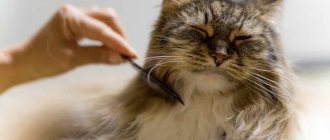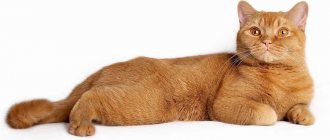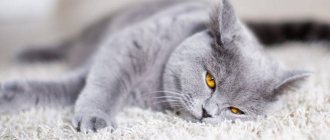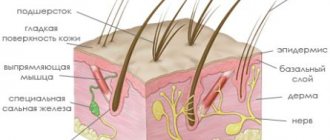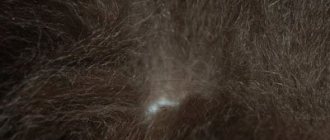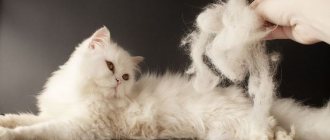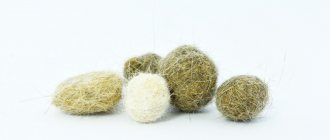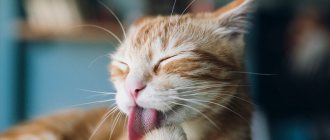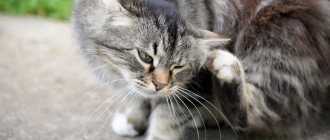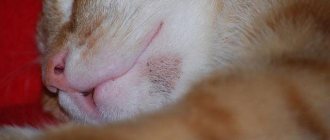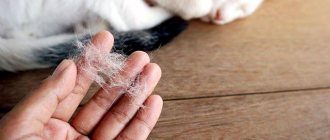It's no secret that pets bring many pleasant moments to their owners. They, in turn, are obliged to carefully monitor the health and good mood of their pets. Proper nutrition and daily care will allow your cat to look just perfect.
Responsible pet owners regularly visit a veterinarian and monitor the health of their pets. Coat care requires special attention. It happens that a cat's hair comes out a lot. What to do? How to help your pet and prevent this from happening in the future?
Causes
First, you should determine why your cat is losing hair and think about whether the negative impact can be eliminated. However, there is no need to panic. If a cat loses a clump of hair, this does not mean that it is dying. The reasons may be different:
Seasonal shedding. Have you noticed that your cat has a lot of hair coming out? What to do? First, take a close look at the calendar. Is your cat not looking sick and hairless, but is actively shedding excess hair? It is likely that she is simply molting. This usually happens twice a year: in autumn and spring. For “apartment” cats that do not go outside, the process may take 2–3 months. There's no need to panic. Instead of the old fur, a new beautiful fur coat will quickly grow.
Dermatitis. It can be allergic and contact. When a cat's fur comes out in clumps and obvious bald patches appear, owners have cause for concern. In the future, bald spots may become covered with scales, turn red and itch. You should immediately see a doctor and determine the cause of the disease. It is likely that this is how the animal reacts to certain foods or new food.
Flea dermatitis. If the resulting bald patches are itchy and covered with crusts and scales, there is reason to suspect a severe reaction to fleas. During this period, the cat’s temperature may rise, and it is very easy to see uninvited “guests” between the hairs.
Skin mite. The disease can be identified by bald paws and muzzle. The hair on the ears also noticeably thins, and throughout the body it becomes dull and unkempt. Self-medication is not enough; you will have to visit a veterinarian.
Lichen. In this case, the hair does not just climb, but falls out in whole pieces. Unsightly bald spots form that quickly increase in size. At the slightest suspicion, you need to show the animal to a doctor as soon as possible.
Stress. A cat can shed heavily in response to new impressions or an unusual environment. The catalyst can be the appearance of other animals in the family, a move, the birth of a baby, the death of the owner, and more.
Avitaminosis. Lack of nutrients, change of feed, seasonal manifestations, lack of certain organic compounds.
Age-related changes. The cat seems to be healthy, but the hair on the ears and face has noticeably thinned out? Your cat is already many years old. In this case, hair loss is associated with poor nutrition of the hair follicles.
Hormonal disbalance. The appearance and thickness of the coat can be affected by pregnancy, estrus, birth and feeding of kittens, and birth control drops and pills that the cat takes.
Treatment at home
If the cause of hair loss is seasonal shedding, then no special treatment is provided. However, during this period it is important to brush your pet regularly. This should be done 2 times a week. This procedure will help prevent the appearance of hairballs in the stomach. In addition, you can give specialized food intended for the molting period. They help remove hair from the pet’s body.
Food that prevents the accumulation of hair in the cat’s stomach is used during the period of active shedding.
To eliminate the problem, which is caused by various pathological conditions, an integrated approach is used. First of all, you need to see a doctor for diagnostic procedures. Then the veterinarian selects a drug that is relevant for a particular disease and gives additional recommendations.
Attention! If a cat is actively losing hair, and there are also pockets of inflammation, then it is not recommended to cauterize the affected areas with iodine or brilliant green yourself, as the reason may be the presence of mites, fungus and other infections. The use of alcohol-containing antiseptics will provoke increased pain and also complicate diagnosis.
Diet for hair loss
A special diet helps with harmless causes of shedding. However, if hair loss is a consequence of a disease, then proper nutrition will make it possible to recover faster, but the factor itself cannot be eliminated. It is important to remove sweet and salty foods from your cat's diet. Under no circumstances should you feed your pet ice cream, sausage, chocolate or raw fish containing many bones.
Raw fish can be harmful to your cat's health
The animal's diet should include products such as:
- chicken;
- cereal porridge;
- special grass;
- vegetables (carrots, potatoes and zucchini);
- fermented milk and dairy products.
80% of a cat's menu should consist of protein foods and only 20% should be carbohydrates. Your pet consumes a sufficient amount of liquid throughout the day, so clean water should always be available. The diet must also include specialized foods containing vitamins and minerals beneficial to the body. It is recommended to give preference to options designed to strengthen and grow the coat: Royal Canin HAIR & SKIN CARE, ProBalance Immuno, as well as the Beaphar Laveta multivitamin supplement.
The first of the presented foods contains a complex of amino acids and vitamins that improve skin condition and promote healthy coat growth. Royal Canin HAIR & SKIN CARE also includes omega 3 and 6 acids, which increase the cat's immunity. Thanks to this food, the coat becomes strong and shiny. Stops excessive shedding.
Royal Canin HAIR & SKIN CARE strengthens the coat and makes it shiny
ProBalance Immuno is a fully balanced food containing a number of vitamins and minerals, as well as active ingredients that can stimulate the animal’s immune system and prevent excessive hair loss. This option is suitable for a daily diet. It can also be used as a preventative against thinning of the coat.
ProBalance Immuno helps improve your pet's immunity
You can also include Beaphar Laveta in your cat's diet. This is a feed additive designed to compensate for the deficiency of vitamins, minerals and amino acids, which have a beneficial effect on the condition of the coat. Available in the form of a solution that needs to be mixed with food.
Beaphar Laveta strengthens the coat and increases the body's resistance
If, after normalizing the diet, active shedding does not stop or additional symptoms appear, then it is recommended to carefully examine the pet’s skin for the presence of mites, wounds, scratches, etc. If defects are detected, consult a doctor immediately.
What foods are recommended to include in a cat’s diet - photo gallery
Chicken should be given to your cat boiled.
Cereals can be given to a cat in the form of porridge in small quantities.
Boiled potatoes and carrots can be added in small quantities to liquid food
Fermented milk products and milk contain a lot of protein and calcium
Zucchini should be given to your pet in limited quantities, but daily.
Grass for cats contains beneficial fiber
The use of medicated shampoos and special preparations
If hair loss is caused by fleas, lice eaters or allergic reactions, then shampoos and medications are used for treatment. When infected with blood-sucking parasites, Outpost Bio is often prescribed for therapy. This shampoo contains natural plant extracts, rids the cat of fleas, ticks and lice, and also improves the condition of the coat.
Outpost Bio destroys blood-sucking insects and improves the condition of your pet's coat
Another option that is used for pathological shedding is “Perfect Coat” 8 in 1. It eliminates excessive hair loss, prevents the formation of tangles and has an anti-allergic effect, which is important if the cat is hypersensitive to any component.
"Perfect Coat" 8 in 1 makes hair combing easier
Another effective option is “Phytoelite” from Veda. This shampoo shortens the shedding period, prevents the appearance of demodicosis, ticks and fleas, and also nourishes the coat and prevents allergies. Can be used for both treatment and prevention.
Phytoelite shampoo prevents excessive hair loss
Medicines prescribed to eliminate pathology:
- Antihistamines: Zodak, Cetirizine, Suprastin, etc. Used for an allergic reaction that provokes itching and thinning of the coat. These drugs eliminate unpleasant symptoms, but do not get rid of the problem itself.
- Antiparasitic: Lawyer, Inspector, etc. These medications are produced in the form of drops, which are applied to the pet’s withers once. These medications are absorbed into the bloodstream and eliminate fleas, ticks, lice and worms. If necessary, re-use is possible after 1 month. However, before doing this, you need to consult your doctor.
- Antifungal: Yam Ointment, Fungin Forte, etc. Prescribed to eliminate microsporia, trichophytosis and other similar diseases. These medications have a detrimental effect on the fungal flora, causing its death.
- Immunostimulating: Fosprenil, Gamabiol, etc. Improve the general condition of the animal, strengthen the body's defenses, thereby stopping hair loss.
- Antibacterial: Amoxicillin, Ceftriaxone, Tetracycline, etc. These broad-spectrum drugs destroy pathogenic microflora and eliminate the source of infection.
These medications are used for the complex treatment of pathological hair loss. The dosage and course of therapy are determined by the doctor depending on the reason that triggered the molting.
Drugs prescribed for treatment depending on the cause - photo gallery
Zodak relieves allergies
Advocate drops are harmful to fleas, ticks and lice
Yam ointment has an antifungal effect
Fosprenil is used for immunodeficiency conditions
Amoxicillin is a broad-spectrum antibiotic
Features of kitten treatment
The kittens' body is very sensitive to treatment with potent drugs, so local remedies are most often used for therapy. For this, depending on the reason, shampoos (Phytoelita, Celandine, etc.), ointments (YAM) and sprays (Stop fungus) are prescribed. First of all, you need to balance the diet of your small pet by including more protein. If the kitten is no more than 2 months old, then the menu may contain only fermented milk products and special food intended for babies.
Royal Canin for kittens has a balanced composition
To restore the coat, special complexes are also used, such as: Biorhythm, Beaphar. These preparations contain vitamins and minerals, as well as antioxidants, which promote the full growth and development of the body. At the same time, hair loss stops and its appearance improves.
Vitamins Biorhythm for kittens promote full growth and development
Unfortunately, not all drugs can be used to treat kittens due to weak immunity and increased sensitivity of the body. Therefore, even local remedies should be used only after the necessary research methods and with the permission of a veterinarian.
How to diagnose hair loss?
How can you tell if your cat has a lot of hair? What to do and how to help the animal?
It is simply impossible not to notice the problem. Cats with long hair lose fur so actively that literally everything becomes covered with hair. Short-haired breeds shed their hair less noticeably, but it is still noticeable. If the pussy is outwardly alert and cheerful, actively eating and playing, but the number of lost hairs has increased, there is no need to worry. We are most likely talking about a trivial molt.
You should take your pet to the vet immediately if:
- The pet's behavior has changed. He is too active or apathetic, shows aggression, sleeps more than usual, scratches himself or chews out pieces of fur.
- The hair falls out unevenly, and bald patches and bald spots appear.
- Hair loss is accompanied by the appearance of wounds, pustules or scales.
- The cat has dandruff, fungal manifestations or other troubles.
The doctor will make an accurate diagnosis and prescribe appropriate treatment. You may need to get tested.
The cat, the cat is climbing a lot, hair is falling out: it’s time for cats and cats to shed
A cat's healthy, shiny hair is the pride of its owner. But what a disappointment if cat hair is observed every now and then in all corners and places in the apartment. The problem of hair loss in cats is not uncommon. Sometimes there is no need to worry, but there are times (and they happen often) when the animal should be examined. Let's figure out in order why cats shed and how to deal with it.
Cat owners know that every day they have to clean up hair in their house or apartment. This is a completely natural phenomenon; people also lose some hair every day.
Important: Twice a year, cats lose more hair than usual. Don't be alarmed right away, this could be seasonal molting.
As a rule, the beginning of seasonal molting is very scary for “newbies”. Experienced owners who have had a pet for several years perceive this phenomenon calmly.
Shedding in cats: what to do?
Seasonal shedding does not depend on the pet’s diet, humidity level in the house, care and other factors. It’s just that a cat changes its summer coat to a winter coat and vice versa. This phenomenon is quite normal, and nothing needs to be done about it. The only thing you can do to help your pet is to brush its fur more often. Molting occurs in spring and autumn. In what time frame - each animal individually.
If you see that your cat has begun to shed, first examine your pet's skin, nose and eyes. If the eyes and nose are clear, the skin is pink, and there are no bald spots, just wait a little. Everything will be back to normal soon.
If the problem is not as simple as it seems at first glance: the fur begins to come out in clumps, the shedding is prolonged, bald spots appear on the animal’s body - this is a reason to immediately consult a doctor.
How to help your pet?
Once your doctor determines why your cat is losing hair, treatment should begin immediately. In some cases, you can do without medications. Sometimes it is enough:
- adjust the animal’s diet, add previously missing products to it, remove excess;
- Regularly brush your pet with a special brush and bathe it;
- do not ignore preventive vaccinations;
- walk your pet more often;
- calm the cat, show care and attention when it comes to stressful manifestations;
- choose a special vitamin complex to improve the condition of the coat.
Hormonal disbalance
This situation most often occurs due to the use of hormonal drugs, such as drops or tablets, which reduce the animal’s sex drive. Thanks to these means, the pet stops marking its territory and demanding a partner. However, such violent interference with hormonal levels does not pass without leaving a trace. If, after using such drugs, a cat’s hair falls out in clumps to the point of bald spots, the cat becomes lethargic, indifferent, eats poorly, and begins to see or hear worse, in most cases this indicates that a hormonal imbalance has occurred. This problem should be solved by a veterinarian by prescribing corrective therapy. Timely sterilization or castration allows you to avoid such problems.
How to treat hair loss?
If hair loss is associated with allergies, the following measures will help:
- identify the allergen, exclude salty and fatty foods from the diet;
- adhere to a special balanced diet recommended by your doctor;
- if you were given dry cat food, it is better to use a medicinal product for wool, recommended for animals prone to dermatitis;
- add special vitamins for wool to food;
- Give antiallergic drugs prescribed by your doctor.
If the dermatitis is of a flea nature, then first you need to get rid of the “neighbors”. Special preparations will help: shampoos, drops, collars or spray.
Self-treating shingles can be problematic. It is important to contact a competent specialist as quickly as possible. You will also have to:
- clean all carpets, bedspreads and furniture in the house with a disinfectant;
- wash and iron all clothes;
- disinfect the premises;
- Throw away, or better yet, burn all bedding, rugs and the animal’s house.
Poor nutrition
At any age, the animal's diet must be balanced. Feeding from your own table is the most common mistake a pet owner makes. With this approach, the animal’s bowl may contain everything that is strictly prohibited for cats: fried foods, sausages, various scraps, leftover salty and fatty foods.
The answer to the question of why a cat's fur falls out in clumps may be a simple desire to save money. For example, the owner buys dry food from the cheapest line. Yes, such food will help your pet get enough, but it will also bring many health problems. After all, its composition is not always optimal, so the effect of such food on the animal’s body can be destructive.
It is worth understanding that choosing a diet is a very important process. It is better to choose dry food from the super-premium or premium category. This diet is balanced and contains all the necessary microelements. Although it costs, of course, more than advertised budget products. But using low-quality food will cost much more, as it will provoke a trip to the veterinarian and long-term treatment.
To determine why a cat’s hair is falling out in clumps, and to understand that the reason lies precisely in the food and improper diet, it is necessary to take into account the following symptoms:
- the main pieces of hair fall out on the back, neck and tail;
- on all other parts of the body the fur began to fade;
- discharge appeared from the eyes, and they themselves became cloudy;
- the ears are inflamed and itchy;
- The bald spots that have arisen at the site of the fallen tufts are inflamed and itchy, the layers of skin in these places have begun to peel off, the animal scratches itself so that sores appear.
How to choose the right vitamins?
So, you noticed that your cat's hair is shedding a lot. What to do? If you are sure that the pussy is healthy and there is no reason to visit the veterinarian, you can simply buy a special vitamin complex. The choice will depend on several factors:
- age of the cat (vitamins are different for kittens and old cats);
- presence of pregnancy;
- preservation of the ability to reproduce (castrated and sterilized animals need a special complex);
- release form of the drug (gel, tablets, drops, paste);
- availability of a product certificate.
What vitamins do cats need?
If your pet’s diet is fairly uniform, constantly consisting of the same familiar foods (for example, poultry and some dairy products), then, on the one hand, this is good. The cat receives the necessary substances from proven sources that do not cause allergies, and absorbs them with appetite. But food is not only a source of fats, carbohydrates and proteins. There are substances that are called bioactive, because without their presence normal processes in the body are impossible. You need very little of them, a fraction of a gram, but their absence has a bad effect on the physical condition of the pet. If we talk about wool, it especially needs the following microelements and vitamins:
- Biotin (or vitamin B7). Its deficiency leads to the development of negative processes in the hair follicles, which provokes hair loss.
- Taurine (an amino acid derivative of vitamin B6). This element is especially important for cats, since it is not synthesized in their bodies. The lack of this substance in the animal’s body leads to serious metabolic disorders, diseases of the gastrointestinal tract and cardiovascular system, decreased visual acuity and eye problems. Of course, this seriously affects the appearance of the cat.
- B vitamins. Promote overall strengthening of the body, have a positive effect on the skin and fur of the animal.
- Calcium. An essential building material that strengthens the teeth, claws and fur of cats.
- Omega-3 and omega-6. Polyunsaturated fatty acids are necessary not only for people, but also for their pets. They ensure normal and harmonious development of the body, therefore they are especially recommended for kittens, pregnant and lactating cats. The largest amount of these substances is contained in fish oil preparations.
- Selenium. A mineral that you only need very little of. It is needed for normal functioning of the thyroid gland and normalization of cholesterol removal. In addition, it is directly involved in the process of hair growth.
- Iodine. It is also necessary for the functioning of the thyroid gland and is associated with many processes in the body, including affecting the brightness of color.
Not every product contains these elements, and in the case of natural feeding, problems with a lack of minerals often arise.
Popular cat vitamins for a healthy coat
There are a lot of preparations to improve the condition of the coat. It is best if they are selected and prescribed by a doctor. The most popular vitamins for cats against hair loss are:
- "Farmavit Neo";
- Cat Felltop Gel;
- "Vittri";
- Laveta Super For Cats;
- "Phytomins";
- Derm Liquid;
- "Sherstevit";
- Derm Caps;
- "Beafar";
- Gimpet Katzentabs;
- "Kitzim";
- Kitty's + Taurin + Biotin;
- Canina Cat-Fell OK;
- “8 in 1 Brewer’s Yeast Excel”;
- "Felvit."
How to help a shedding cat?
We recommend using a comb regularly to not only comb out excess hair and dead skin flakes, but also check them as you go. The vast majority of cats enjoy being groomed and petted by their owners, so you should have no problem keeping your feline friend sitting still for five minutes while you go to town with the brush. The sooner we start, the more likely the kitten will tolerate it, so it's best to get him used to this routine. As we said earlier, keep an eye out for any indicators of potential problems such as small bumps, red skin, cuts, irritation, mites, fleas, etc.
It may also be a good idea to keep a journal of sorts for your pet. By this we mean that you should write down your cat's characteristics as you brush its fur. What is the quality of the fur? Do they have bald spots? What color? What is the texture like? What does it look like? Are there any stains? Is there any redness? How does their skin feel? Keeping a regularly updated log of this information allows you to instantly understand when something is not as it should be.
Article Author: Dr. Linda Simon is a veterinarian with seven years of experience. She is a member of the British Veterinary Association and specializes in veterinary medicine. In addition, she has been working as a veterinarian for Woman magazine for the past two years and writes a regular column for them on pets and their health.
Furminator for hair care
To help your cat renew its coat faster and get rid of tangles, it is best to use a special device. The Furminator is perfect for long-haired cats. Initially, the word was the name of the trademark of one American company, which developed the device. Now this is the name given to all manual “combers” that combine the functions of a slicker, comb and trimmer.
A cat's fur is not like human hair. Several hairs grow from one follicle at once: central; 2–3 additional, undercoat and down. In order for the animal to look beautiful and neat, the old fur must be removed. Otherwise, your cat will shed all year round.
Regular combs are not able to process the undercoat; special combs damage the top layer of skin. The Furminator for long-haired cats does not have all these disadvantages. Outwardly, it is similar to a razor, but instead of a traditional blade, it has a special metal comb with sharpened teeth. With its help it is very easy to process the undercoat and remove dead hairs. Living hairs remain intact.
Do all cats shed: a godsend for allergy sufferers
Probably, there is no need to explain why the animals from the following list will never encounter the problem under discussion - they simply do not have that dense and abundant coat that forces the owners of Persians, Bobtails and Maine Coons to look for new ways to deal with hairs settling on all possible surfaces.
- The Sphynx is one of the most popular breeds; its representatives look completely hairless, but in fact they have very short fur, similar to suede - small and fluffy. These are pets that are “not for everyone” – the animal’s peculiar appearance can scare off many cat lovers.
photo from the site: zamanula.ru
- The Peterbald is a cross between a Sphynx and an Oriental - a graceful animal with thin legs and a slender body. The homeland of these unusual cats is Russia. Based on the presence and abundance of fur, they are divided into several groups: hairless, flock (with short hairs similar to fluff) and brush (coat is hard and curly).
photo from website: murkote.com
- Devon Rex – the skin of this alien creature is covered with wavy curls. Representatives of this breed do not cause allergies, have a cheerful disposition and will definitely appeal to those who prefer unusual pets.
photo from website: murlo.org
- Ukrainian Levkoy - long-legged and flexible fold-eared hairless cats - is an excellent option for those who want to have both a Scottish Fold and a Sphynx at the same time. Such pets are extremely sociable and easily make contact.
photo from the site: ZooPicture.ru
How to choose the right device?
To choose the right furminator, it is important to pay attention to the following points:
- Scallop width. The larger the animal, the wider the comb should be.
- Length of teeth. It should match the length of the animal's fur. Teeth that are too short will not reach the undercoat of “fluffy cats,” and teeth that are too long will not be suitable for short-haired cats.
- Quality of tooth sharpening. They should be even, smooth, without nicks or irregularities. Defects in sharpening interfere with quality combing. Irregularities will tug the fur and injure the skin. To check the quality of sharpening, run the furminator over your own head. If you do not experience any unpleasant sensations, the quality of sharpening is normal. Pulling hair? The sharpening was unsuccessful.
- Ejector button. Its presence allows you to get rid of hairs on the work surface in one motion. It must be remembered that such devices fail faster.
- Comfortable handle. It is best if the handle is rubberized, has a convex relief and a rounded end. Hold the Furminator in your hand, feel its weight, and measure the length of the handle against your palm.
Not long ago, universal furminators went on sale. They have removable combs of varying lengths and widths. With their help you can care for several pets of different sizes. But the moving connection becomes loose over time and the device becomes unusable.
Worms
These parasites bring a huge number of problems to the body. Hair problems in this case are a secondary symptom. First the fur becomes dull and then falls out. Digestive problems arise, the animal experiences general weakness, bad breath, weakened immunity, and impaired appetite. If you do not treat your pet in time, it can lead to serious consequences and even death. It should also be understood that many types of worms are transmitted to humans. Therefore, prevention should be done in a timely manner.
Grooming rules
A good cat hair brush is not the only thing a responsible owner will need. It is very important to bathe cats of any breed. Moreover, this must be done at least 3 times a year. Of course, the cat itself regularly cleans its fur using its tongue. But it will not be able to cope with microscopic particles of sebum and dust. Over time, they clog pores and the skin receives less oxygen. The animal's fur becomes dull, brittle and falls out more.
For bathing, you should use special products for cats: shampoos and conditioners. It is unacceptable to use “human” ones. Owners of long-haired animals have even more worries. Several times a year they need to give their pets a “dry” bath. To do this, you need to sprinkle a special powder on the animal’s fur, and after some time comb it out thoroughly.
It is very important to brush your cat properly and regularly. Long-haired dogs should undergo this procedure daily, and short-haired dogs should undergo this procedure at least 2 times a week. Combing does more than just get rid of dead hairs. It is also a kind of massage that stimulates blood circulation.
When a large lump of matted fur is discovered during combing, it is worth trying to disassemble it. If it doesn’t work out, you must definitely get rid of the tangle, for example, cut it out. If this is not done, it will increase in size and can become a source of infection or a nest for fleas.
Skin diseases
If a cat develops sores on its skin and hair falls out in clumps, there is a high probability of pathology. In most cases, dermatological diseases are accompanied by severe itching and suppuration in the areas of scratching.
Ringworm and other fungus
Dermatophytosis, or infectious skin diseases caused by fungi, is contagious to humans. Infection with lichen is accompanied by itching, deformation of the claws, redness and peeling of the skin. The main symptom of this pathology is the focal formation of bald spots, which over time merge into more extensive lesions.
Malfunctions of the endocrine system
Hormonal disturbances not associated with postpartum activity may indicate disturbances in the endocrine system. Most often this occurs after taking hormonal drugs that suppress sexual desire. Another characteristic symptom, in addition to constant itching, is symmetrical hair loss on both sides of the body.
Folliculitis
Folliculitis is an inflammation of the hair follicle caused by poor animal care. Small ulcers with yellowish-green contents appear at the base of the hairs. Most often they appear on the neck or face, causing severe itching. When an abscess ruptures, pathogenic microorganisms quickly penetrate into it, causing a secondary infection.
The occurrence of dandruff
The cause of baldness in cats can be dandruff, that is, a dry form of seborrhea. It occurs when sebum production is reduced, disrupting the skin's natural exfoliation cycle. In addition to dandruff, dry seborrhea is accompanied by itching, an unpleasant odor, thinning and excessive loss of hair follicles. Most often, this condition is explained by a decrease in immunity, but sometimes the root cause lies in flea or tick infestation.
Tick or flea infestation
Infection with ectoparasites, which inject foreign protein during feeding, is always accompanied by itching. The animal itches constantly, gnawing into the affected areas and biting off pieces of fur. Scratching can lead to a secondary infection in the wounds. Suppuration begins.
The location of the lesion depends on the type of parasite. They can live on the back, paws or tail. Some mites (especially scabies) dig their tunnels right under the eyes of the unfortunate pet. Due to unbearable itching, the cat becomes apathetic and irritable. He sleeps poorly and refuses to eat. His weight is dropping and his condition continues to deteriorate. Dandruff appears on bald areas.
Oncology
The body spends all its strength to fight malignant neoplasms. There are simply no resources left to nourish the hair follicles. If your pet is constantly thirsty, suddenly loses weight, suffers from bloating, upset stools and bouts of bloody vomiting - do not hesitate and immediately sign up for a diagnosis. Oncology detected in the early stages is treatable.
Alopecia
Alopecia is one of the types of hair loss. It can be caused by all sorted reasons, suggesting the appearance of partially or completely bald areas on the body. If the loss of hairs is not frightening (molting), then it is not classified as alopecia.
Hypotrichosis
With this genetic anomaly, the kitten's fur disappears in the first months of life or is absent at birth. This alopecia is not always generalized - some areas of the skin may retain hair. Bald areas become darker and often suffer from seborrhea.
Due to its peculiarity, the baby remains forever vulnerable to direct sunlight and severe frost. As he grows older, his skin becomes rougher and less vulnerable, but the increased risk of burns and frostbite remains.
Solar dermatosis
Solar dermatosis is an inflammatory disease that develops with high sensitivity to ultraviolet radiation. The pathology occurs in pets with a white coat that are devoid of melamine. This pigment is not only responsible for color, but also provides sun protection.
When exposed to sunlight, the animal's skin turns red and hair falls out. The affected areas begin to peel off and itching appears. Despite the absence of pain, irritation is difficult to miss. Without treatment, ulcers appear in its place. Increases the likelihood of developing skin cancer.
Baldness at the injection site
Baldness is one of the side effects of subcutaneous injection of certain drugs. In most cases, the injection site is quickly restored. If the bald spot persists for too long after vaccination or antibiotic therapy, consult your veterinarian.
Preventing Excessive Shedding
To keep your pet healthy and its fur not decorating your trousers, carefully monitor its diet:
- do not give your animal harmful foods: spicy, smoked, salty or fried foods;
- if you use ready-made food, purchase only a high-quality product from a well-known brand;
- include a sufficient amount of vitamins and microelements in your diet;
- do not overfeed your pet, especially if it is not young;
- Take your cat to the veterinarian regularly and do not neglect the required vaccinations.
Even if your cat has never been outside, this does not mean that she cannot get sick. We bring a variety of infections home ourselves, on clothes and shoes.
Allergy
In most cases, as in humans, an allergic reaction in an animal manifests itself on the skin. The hair falls out symmetrically in parallel, redness appears on the skin, and the ears become inflamed and itchy. Most often, allergies are caused by some food product, including feed. In such cases, the diet is simply adjusted.
But the problem may not always be food. Allergies can occur to grooming products or to the material from which the bedding or bowl is made. If the allergy is not related to food, you need to temporarily limit the animal from all its things. After the allergy has stopped, you should return one item at a time and carefully observe, after which the allergic reaction will appear again. Accordingly, this item will subsequently need to be removed from the cat’s everyday life.
